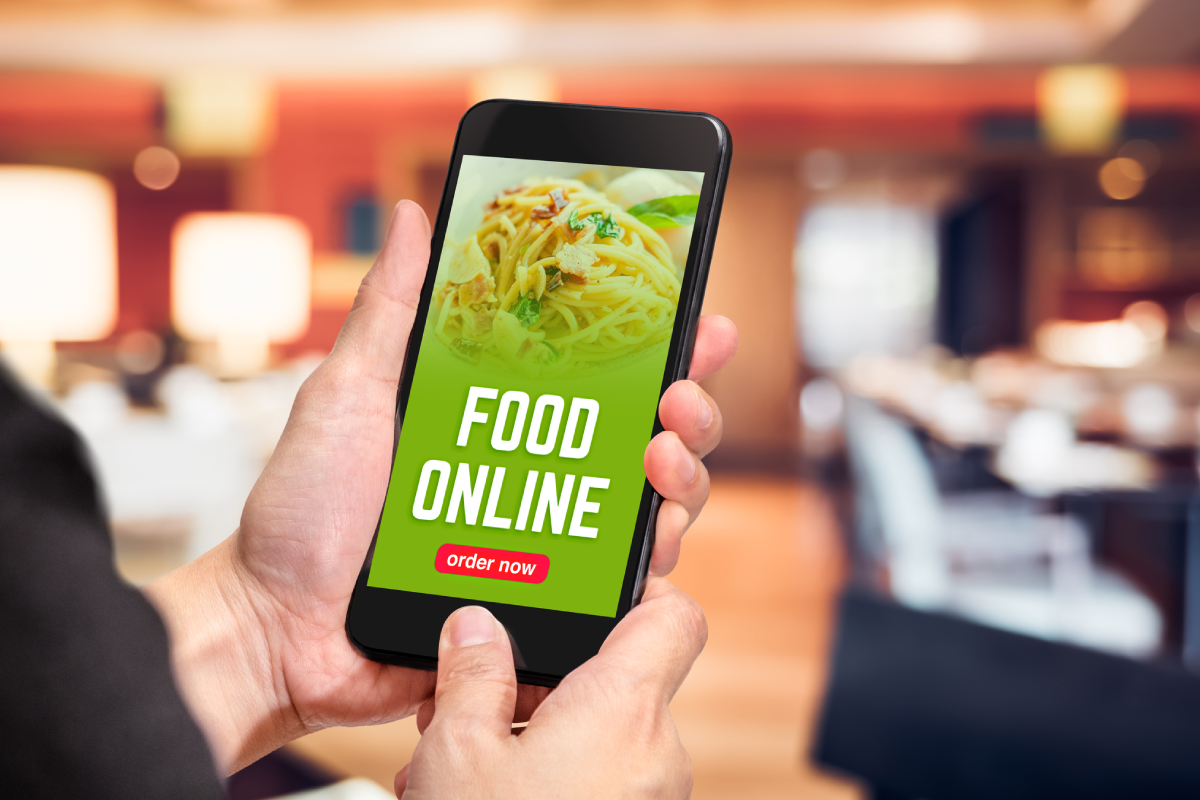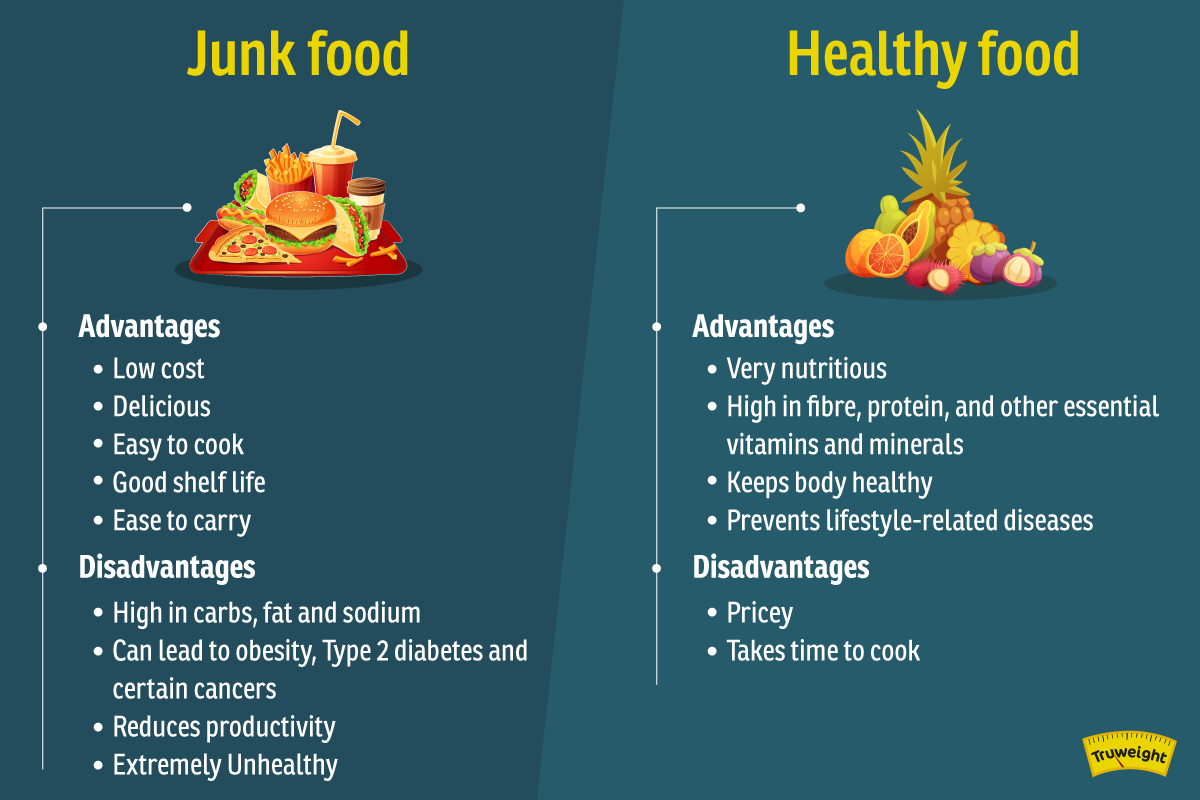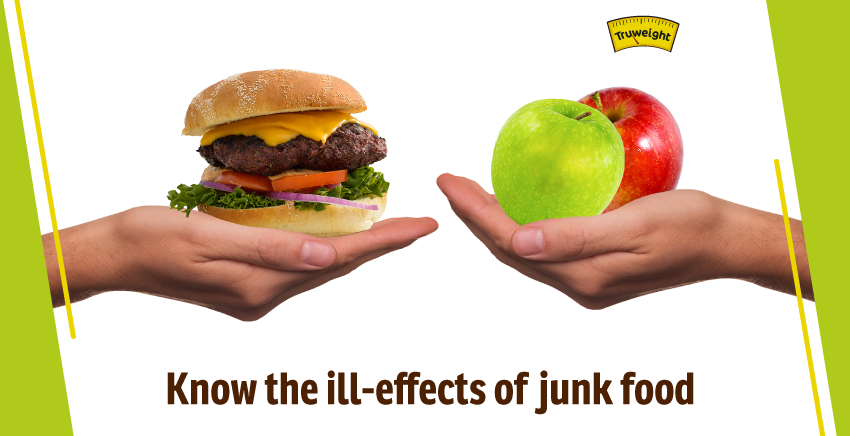Medically reviewed by Dr. Shunmukha Priya, Ph.D. in Food Science and Nutrition
In the past decade alone, the consumption of junk food among the population has multi-folded steadily. Junk foods excite your taste-bud, it’s much cheaper to buy and packaged foods take less than 10 minutes to cook. These factors have made junk foods extremely popular in the food market.
While enjoying these benefits, we tend to forget one thing – the nutritional quotients of what we eat. We might have heard stories of mothers reprimanding their children if they eat out too often or bring junk food home. Well, those admonishing happened for a reason – the lack of nutrition in junk foods.
Table of content
- Junk foods – An Introduction
- The story behind junk foods
- Role
- Types of junk foods
- Identifying junk foods
- Children and junk food
- Adolescents and junk food
- Role of food delivery services
- Its harmful effects
- Junk food vs. healthy food
- How to incorporate healthy eating
- Conclusion
Studies have collectively agreed that junk and fast foods are extremely high in fat, sugar and salt (HFSS). These foods are very high in calories that do no good.
From the commencement of junk foods to its prevalence across the globe, we bring you all about this unhealthy food and the effects it has on the human body in the long run.
Junk foods – An Introduction
The idea of junk foods was introduced to the world in the late 1880s and early 1900s. According to ‘Encyclopaedia of Junk Food and Fast Food’, the first junk food that was introduced in America was Cracker Jack by Frederick and Louis Rueckheim in the year 1896.
The brand went on to capture the American market and since then, there has been no looking back for the junk food market.
During the 1900s, packaged and processed foods quickly occupied the world food market and the advent of transportation made it easier. By the 1950s and 60s, packaged commercial foods were introduced to a number of countries, especially in the west. After the late 1970s, India also caught up with the trend. [1]
The 1900s was an era for fast food chains as well. The 1950s and 60s saw the emergent of McDonald’s which would later become an extremely popular fast-food chain. With McDonald’s, the franchise market also boomed.

During a time when you had to wait for several minutes to get your meal in a restaurant, the concept of a fast-food chain that provides a meal in less than 10 minutes had people thronging.
By the late 1990s and early 2000s, fast food chains cropped up in India. At the end of 2010, fast food restaurants became a thing in the country. By the end of 2022, the food market in India is estimated to be Rs 5, 52,000 crores. [2]
The success behind junk foods
Determining the success of junk foods is no rocket science. From attractive packaging to increased shelf life, several factors make junk food appealing to the masses.
1. Time
Foods like pizzas and burgers are very easy to prepare since the primary ingredients are precooked and readily available. Customers can get their meal as quickly as possible, saving them a lot of time.
Likewise, packaged foods like Lay’s, Cheetos, fruit cakes, biscuits etc can be eaten right out of the package. These foods do not require so much as a preheating let alone cooking. This propels teenagers and young adults to choose packaged foods who are always on the go.
2. Taste
Fast food and junk food makers add additives, artificial flavours and use an excessive amount of salt, oil and sugar than the recommended amount to enhance the taste.
Kids, youngsters and adults alike develop a taste-bud to these flavours and resort to eating junk foods often.
3. Attractive packaging
Proprietors behind the packaged foods industry have long learned the art of the visual appeal.
Be it a regular store or a huge supermarket, bright and attractive packages of junk foods have drawn the attention of both children and adults.
This makes the consumers curious and urges them to buy the product just to know how it tastes.
4. Shelf life
Ready to cook junk foods as instant noodles and pasta come for a very long time without refrigeration.
Other packaged foods like crisps, biscuits, wafers etc also have a longer shelf life making it an easy option for snacking.
5. Transportation
Unlike regular wholesome foods, carrying junk foods is hassle-free, thanks to the impeccable packaging.
The well-developed transportation system that we enjoy today has also contributed to this factor.
6. Affordable cost
Compared to healthy foods, junk foods are priced very low. A small sized chips packet costs only Rs 5 when compared to 50 g of almonds that can cost more than Rs 50.
This price difference has made junk foods affordable for all.
Role of advertisements
In the recent past, the marketers of junk food products have cleverly used advertisements to their advantage.
Studies conducted on television advertisements and its impact on children determined that advertisements aired on children’s TV channels influenced the latter’s choices and behaviour.
The bright and colourful visuals used for depicting junk foods trigger children to want these foods and the taste factor makes them addicted to it. These advertisements were aired majorly during the prime time targeting a maximum number of children and parents.
Following television, internet and smartphone users became the prime target for junk food advertisers. Since even children are drawn towards smartphones, the popularity of soft drinks and fast foods grew fast and vast.
Additionally, advertisements on billboards, banners and peer pressure contributed to this junk food craze.
Types of junk foods and how to identify them
Junk foods have donned various avatars since its introduction. They come in the form of crisps, pastries, pizzas, burgers, instant noodles and pasta, biscuits and oil-laden ‘traditional foods’ sold in local eateries and restaurants.
- Fast foods: Eateries like Pizza Hut, Dominos, Burger King, McDonalds etc fall in this category. In these eateries, tasty pizzas and burgers are prepared in a very short amount of time making it very appealing to the younger generation. However, these foods are quite pricey and not everyone can afford it.
- Ready-to-eat packaged foods: Foods like Lay’s, Cheetos, Oreo, packaged baked goods etc are considered as ready to eat junk foods. These foods are cheaper and can be bought by anyone.
- Ready-to-cook packaged foods: Instant noodles and pasta fall in this category. It takes less than 10 minutes to cook these foods which are loaded with additives and artificial flavours.
- Soft drinks: We all are familiar with drinks like Coca-Cola, Pepsi, 7UP, Fanta etc. These are carbonated drinks extremely high in sugar and have tons of chemicals and additives in it.
- Restaurant food: These foods are usually native foods sold in local eateries unless stated otherwise. Though traditional in nature, unlike home-cooked meals, these foods are high in fat.
Identifying junk foods
Simply reading the nutritional values printed behind the package will enlighten you about the food you are eating. [3]
You can tell the food you are eating is junk if,
- The calories from fat are more than 35%
- Saturated and trans fat contribute to more than 10% of calories
- The calories contributed by sugar is more than 35%
- Per serving is more than 200 calories (especially snack product)
- The sodium (salt) is more than 480mg/serving
- The primary ingredient is eir oil or sugar
- The product is high in fructose (corn syrup)
Children and junk food
Studies have reported that the consumption of junk food has increased among children (less than 12 years old). The frequent advertisements have made junk food attractive to them. Children in general, prefer snacking on crisps, biscuits, sweets and cakes rather than nuts, vegetables and fruits.
Likewise, lifestyle choices parents make also influence a child’s eating habits. When you take children to restaurants frequently, they naturally believe that it is totally acceptable to eat outside food often. Children these days are so used to drinking artificially flavoured drinks that they cringe at milkshakes and juices that contain real fruits.[4]
Another key element adding to this problem is the lack of physical activity. Gone are the days when children used to play with their counterparts at outdoors. Children being glued to smartphones have become a common sight. Excessive junk foods coupled with little to no physical activity has upped childhood obesity.
Adolescents and junk food
Adolescence (aged between 13 and 21) is also called as the ‘growth period’. Just in a matter of years, teenagers grow long pairs of limbs and their appetite doubles. This means, eating nutrient-dense foods is a must.
However, teens of today eat foods that are far from nutritious. They are exposed to unhealthy lifestyles and subjected to peer-pressure. They also go through myriad emotions.

Teens are more attracted to foods like pizzas and burgers than home-cooked wholesome meals. Children and adolescents disliking vegetables have become so common that it is unsurprising. Few studies also noted that teenagers tend to consume more refined carbs since their appetite is increased.
Additionally, foods offered in school and college canteens are doing no good. Canteens usually sell foods like puffs, rolls, sandwiches and soft drinks. These foods are high in unhealthy calories, sodium, fat and carbohydrates. Even regional foods sold by these eateries are loaded with fat (ghee/oil) and have very little vegetables. Similarly, superfoods like millets and ragi are seldom used by these suppliers.
All these factors make awareness of the need of the hour. It is important to note that what teens eat now have a larger impact on their health in the future. When these food habits go unchecked for a long period of time, these teens may develop diabetes and cardiovascular disease during their adulthood.[5]
Role of food delivery services
In the last decade, food delivers applications like Zomato, Swiggy and now UberEats has carved a niche in the food industry. Though they have benefitted a number of individuals and sectors, they have also increased the junk food consumption in away.

Since these food delivery apps deliver the desired food to the doorstep, a number of people simply order calorie-laden food to their home. The added convenience here has only increased the usage of these apps. People are now ordering outside food more often than ever-increasing their junk food intake. [6]
Junk food and its harmful effects
What we eat now has a profound impact on our health in the future.
Studies have pointed out that when children and teenagers eat junk food every day, they are very likely to develop obesity and Type 2 diabetes and even certain types of cancers when they become adults. Little to no physical activity can also increase the chances of developing cardiovascular diseases.[7]
A Harvard article reported that people who eat excessive added sugars can die of heart diseases even though they are not obese. Time and again, nutritionists and health specialists have advised against drinking energy drinks and sodas that are loaded with sugars. These drinks are called empty calories since they contain no vitamins, minerals or fibre. [8]
Another study observed that eating junk foods affect our productivity. Our body processes junk food quickly. This leads to a spike in blood glucose level.
When the body’s digestive system works extra hard to digest the food, the oxygen supply to the brain is reduced. This is responsible for the grogginess we experience to post a heavy meal. This directly affects brain function and productivity.[9]
Junk food vs. healthy food
This is a topic that has been debated often. Despite junk food is unhealthy, it has advantages of its own like affordable cost, tasty, ready to cook and shelf life. Whereas, healthy foods are a lot more expensive and need cooking before it can be consumed.
However, one must consciously choose between the two if they wish to lead a healthier life. Yes, healthy foods are high-end and cooking might pose a slight hindrance if you are a busy person. But clean eating and a good amount of physical exercises will reward you in the long run.

By avoiding junk foods, you are preventing several lifestyle-related diseases and saving thousands of rupees on your medical bills. Here are some of the advantages and disadvantages of healthy foods and junk foods.
How to incorporate healthy eating
A little lifestyle changes here and there is all you need to include healthy eating habits in your life. Simple steps like replacing fruit drinks with real fruits will go a long way.
Here are some tips that you can consider to cultivate clean eating habits.
1. Cut out whites (except dairy)
Firstly, reduce the intake of refined white rice, pasta and maida which are gluten-rich. Since these foods have simple carbs, the body digests it quickly spiking the glucose level. This process makes you hungry sooner and prompts you to eat more.
2. Add fibre and protein
A healthy diet should be rich in protein and fibre. Include lentils, pulses, legumes, eggs, lean meat like fish and chicken for protein. For fibre, eat foods like millets, Ragi and Jowar, brown rice or red rice.
3. Include vegetables and fruits
Eat plenty of vegetables, especially greens. Remember to eat fruits at least twice or thrice a day. These will provide the necessary micronutrients for your body.
4. Eat nuts
Replace junk snacks with nuts. Nuts are full of good fat and a great option for snacking.
5. Drink water
Replace sodas and energy drinks with water. Water will keep your body hydrated and well-nourished.
6. Make time for cooking
Homemade meals are best any day. These meals are wholesome and since you cook them, the ingredients are fresh.
7.Plan your meal
If you are struggling to get out of the junk food habit, plan your meals. Cook them and take it to your work. Your food is not only sorted but you also have a healthier option now.
8. Stock fridge with clean foods
Instead of junk foods, stock your fridge with fruits, vegetables, eggs, nuts, etc.
9. Avoid sugary drinks
When you are thirsty drink plain water, buttermilk or tender coconut water instead of sugary sodas or drinks. These drinks are loaded with empty calories and offer no nutritional value. Also, these drinks are responsible for obesity and weight gain. [10]
Conclusion
In today’s fast-paced world, eating junk food is much easier than eating healthy, wholesome foods. To overcome this menace, we need to vigorously spread awareness about the ill-effects of eating junk foods.
If your child loves eating junk food, speak to him/her about it and make the effort to cook wholesome meals not just for your child, but for your whole family. Following the aforementioned tips can have a positive impact on your health and wellbeing.
Eating clean can take some effort but it is not unachievable. If you are unsure about how to proceed, speak to a nutritionist who can guide you better. Just like how oil is important to keep the engine running, healthy eating is important for nourishing the body.
When you eat healthily, your body is active and your mind is productive. You feel more energetic than before. Well, what are you waiting for? Pick that kale today and reap the benefits tomorrow! Happy binging on those nuts and veggies!
FAQ’s
Q: Is junk food healthy?
A: No, junk food is not healthy
Q: How junk food affects your health?
A: Eating junk food often can lead to lifestyle-related diseases like obesity and diabetes etc.
Q: How junk food affects children’s health?
A: Eating junk food often can cause childhood obesity in children and they tend to become lazy.
Q: Can junk food cause cancer?
A: Excessive junk food consumption may lead to the development of certain types of cancer.
Q: Is junk food and fast food the same?
A: Yes. Fast food is a type of junk food.
